«previous pageCOMMUNITY SERVICE CATEGORY
Honor Award
International Student Center Rain-Garden
Aarthi Padmanabhan, Student ASLA, and Jeremy Merrill, Student ASLA
Kansas State University, Manhattan, KS
faculty advisors: Lee R. Skabelund, ASLA, and Dennis Day, FASLA
Project Statement
The International Student Center Rain-Garden educates students, faculty, staff, administrators, and campus visitors about low-impact stormwater management solutions by revealing how designed landscapes can elegantly capture and use rooftop and surface water runoff. This rain-garden strategically addresses a significant hurdle to integrating natural stormwater management systems within the urban fabric- namely, the lack of public knowledge of and appreciation for the function and design of these systems- by integrating art, architecture, ecology, hydrology, and people.
Project Narrative
Project Goals and Objectives
Primary Goals of the International Student Center (ISC) Rain-Garden:
- Engage students and faculty in a collaborative design-build and service-learning project.
- Help restore the natural hydrological cycle along the Campus Creek riparian corridor.
- Educate students, faculty, staff, administrators, and campus visitors about low-impact stormwater management solutions by designing and constructing a rain-garden that elegantly captures and uses rooftop and surface water runoff.
Specific Educational Goals:
- Help each participant deepen their collective knowledge of both natural and human systems- and how these understandings can be specifically applied to urban stormwater management.
- Necessitate collaborative, interdisciplinary, cost-effective, and beautiful project work.
- Require critical thinking about the relationship between design, implementation, and management.
Analysis, Options Considered, and Interested Parties Involved
During Fall 2006, the Campus Creek Stormwater Management Planning/Design Charrette and related university coursework involved over 125 students, faculty, staff, and professionals in the task of considering ecologically-sound ways to treat stormwater on campus. In the process, the following results were achieved:
- Many ideas for rain-gardens, bio-retention cells, streambank improvements, and other stormwater best management practices (BMPs) were generated during a one-day interdisciplinary charrette. Watershed analyses, water quality monitoring, and contextual site assessment work were undertaken through a "Natural Systems & Site Analysis" course and served as important references for subsequent rain-garden design explorations. Analyses and design ideas generated during Fall 2006 continue to inspire facilities personnel as implementation plans are developed for various parts of the Campus Creek Watershed. As a result, the negative impacts of rapid, pipe-to-stream stormwater runoff are beginning to be addressed on campus, so that Campus Creek streambanks can be stabilized and water quality improved.
- Local planners, designers, engineers, other professionals, and community leaders were informed about the project and invited to participate. A number of professional designers and engineers attended lectures presented by stormwater management experts and participated in the charrette. During pre-charrette presentations, charrette-related explorations, field tours, and subsequent meetings and open houses many innovative ways to address urban stormwater runoff were demonstrated to campus administrators, to facilities and ISC staff, to university faculty and students, and to visitors to the campus. Local city planning and engineering staff, other professionals, and many local citizens in the region have visited the rain-garden and expressed a keen interest in learning more about the project. Other rain-gardens have been created as a result of this project.
- The ISC Rain-Garden (the first rain-garden in the community) has created tremendous interest on campus about the prospect for retrofitting water-and-energy-intensive buildings and landscapes and creating a more sustainable campus environment. Because of the way it speaks to the site and its bio-regional context, this perennial garden has become a touchstone for regional excellence in natural systems based stormwater management.
Design Process
The ISC Rain-Garden was designed to relate to the architecture and the cultural sensitivities of the ISC and was implemented using a $5,000 water quality service-learning grant- with additional support from the state, university, local businesses, suppliers and contractors. The garden is comprised of a variety of plants- some that can withstand wetland conditions and many that can tolerate hot, droughty conditions common in the region. The garden has an intentional, formal structure that embraces a naturalistic planting design. Vegetation in the bottom of the two small basins receives more water than species elsewhere; plants nearest the building receive less sun so that heavy clay soils in this area remain moist for a much longer period of time. Many of the species found within the garden are perennials (flowers and grasses) native to the Flint Hills Eco-region. The garden was designed to catch and slow stormwater runoff pouring off the ISC's Taiwan Wing rooftop as well as nearby areas dominated by turfgrass- thus lessening the amount of water flowing quickly to Campus Creek. Within the first year-and-a-half, the garden was typically able to infiltrate stormwater in less than 24 hours. The garden clearly shows how property owners can reduce runoff volumes while also eliminating or minimizing pollutant and sediment loads to nearby surface waters. The location and design of the garden (including basins and berms, permeable walkways, splash-pads, and a level-spreader) help reduce the impacts commonly associated with stormwater runoff.
Project Implementation
During Spring and Summer 2007, this collaborative design-build project engaged students, faculty, staff, and professionals in the task of implementing a two-cell rain-garden at the International Student Center . Since that time, faculty, staff, and students have been actively maintaining the garden. To date, approximately 90 students, faculty, staff, and professionals have participated in rain-garden construction and ongoing monitoring and management efforts. ISC staff and students participate in maintenance of the garden.
Implementation included: preparing detailed rain-garden designs; researching and coordinating purchases, donations, and transport of all necessary equipment, tools, and materials; excavating, rototilling and grading the two shallow basins; removing weeds, roots, and sod and transplanting four existing shrubs; placement of nine large limestone slabs to relate the garden to the ISC's eight-foot grid and to serve as stepping stones and pathways through the garden; preparation of the base areas for the two pathways on the north and south sides of the rain-garden; placement and settling/compaction of washed filter stone (gravel) to support the cut pavers along the formal path (on the north side) and the flagstone along the informal flagstone path (to the south); laying cut pavers, heavy edging stones, re-used metal edging, pieces of flagstone, and filler gravel; placing three salvaged limestone pieces (splash-pads) below roof scuppers; repairing storm-damaged areas after heavy rainfall (more than five inches over 36 hours) damaged unfinished areas of the flagstone path and adjacent berm; coordinating the spraying of weeds and plant protection; planting a combination of moist rain-garden, dry fringe (shady to full sun), woodland, ornamental perennials, and woody plants during five different planting days; ordering, hauling and placing five loads of donated mulch; watering plants from rooftop runoff (and by hose as needed); collaborating with sculpture faculty and students to design, fabricate, and install three silicon bronze rain-bowls; collaborating with bio-agricultural engineering faculty and students to do infiltration tests; regularly weeding; soliciting donations; coordinating volunteers; tracking purchases, budgets and project costs; taking photos; and designing and coordinating the fabrication of an interpretive sign (recognition plaque).
Project Monitoring
Visual observations indicate that the rain-garden readily collects and infiltrates rainwater falling on the ISC's Taiwan Wing and the garden's up-slope watershed from storm events less than approximately two inches. Monitoring vegetative health began in June 2007. Four soil density probes and four infiltration tests were completed in April 2008 and provide a sense of soil conditions within and immediately down-slope of the ISC Rain-Garden. Additional infiltration testing will likely be done in the coming years to see just how quickly water infiltrates into the rain-garden. Bulk density tests will also likely be done to see if soil densities decrease over time (which should occur if compaction/foot traffic is minimized and as native grasses and forbs continue to mature). Ongoing monitoring will help communities learn which plants are best suited for the particular site conditions and show how infiltration rates and soil densities change over time, thus providing important information for future rain-garden and bio-retention designs within the Flint Hills Eco-region. The rain-garden is also a vehicle to educate visitors about the importance of ongoing site maintenance and monitoring.
Other Significant Issues
This project is part of a larger vision for creating a more sustainable campus ? with water conservation, stormwater management, and energy efficiency as primary drivers of proposed activities. The International Student Center Rain-Garden achieves this vision by beginning the process of restoring and revealing the natural hydrologic cycle in an aesthetically pleasing manner and connecting the garden and its users to adjacent buildings and landscape. The garden demonstrates to administrators, campus facilities and grounds personnel, faculty and students, and a wide range of visitors how rooftop water can be readily collected and re-used to nourish a perennial garden consisting of plants native to the Flint Hills Eco-region while also responding to unique site and architectural characteristics. Rain-garden installation used salvaged limestone from a local stone company, thus reducing embodied energy during construction. The garden demonstrates creative use of rain-bowls, splash-pads, a level-spreader, and permeable pavers (employing salvaged cut stone and native flagstone) to slow, temporarily hold, and infiltrate stormwater falling on or entering the rain-garden.
University personnel, initially skeptical about the ability of very heavy clay soils to properly infiltrate water, now recognize the importance of biological approaches to stormwater management on campus. After breaking up the soil and establishing plants, the dense rain-garden soils now readily infiltrate water while vegetation effectively evapotranspires collected stormwater runoff.
Additional Project Credits
2007 Primary Student Team Members
Cary Thomsen
Mark Ruzicka
Tor Janson
The three students noted at the top of the credits section were part of more than 140 students, faculty, and staff who contributed to various phases of the project between 2006-2009. Cary, Mark, and Tor were students in the Department of Landscape Architecture/Regional & Community Planning (LARCP) in 2007 and the majority of volunteers came from LARCP.
Spring and Summer 2007 expenditures for the project were $4,982.86, and were covered by a Campus Compact WaterLINK (service-learning) grant.
Financial support for a small portion of the time provided by the two co-designers (Cary Thomsen and Lee R. Skabelund) came from a USEPA/KDHE grant, as noted below.
KDHE provided financial assistance to the KSU ISC Rain-Garden Project through EPA Section 319 Nonpoint Source Pollution Control Grant #C9007405-12.
Three WaterLINK (Water Quality Restoration and Protection Service Learning Mini-Grants totally $10,000 awarded to KSU by KDHE utilizing USEPA funds) provided financial assistance for the Fall 2006 KSU Campus Creek Planning/Design Charrette, Spring & Summer 2007 ISC Rain-Garden construction for the KSU ISC Rain-Garden, and Spring 2008 ISC Rain-Bowl fabrication and installation (with purchased rain-bowl materials totaling $2,059.12).
Materials, assistance, and in-kind support came from the following: The Civitas Group, Atwood Rentals, Bayer Stone, Higgins Stone, Midwest Materials & Concrete, Coonrod Construction, Bayer Construction, CritSite Prairie & Wetland Nursery, Applied Ecological Services/Kaw River Restoration Nurseries, Blueville Nursery, Bluebird Nursery, Horticultural Services, Three Rivers Engraving, KSU Facilities & Grounds (with project approvals by Mark Taussig and project support by Jackie Toburen), KSU College of Architecture, Planning & Design (with equipment and tools loaned by David Mitchell).
Thanks to Donna Davis and other staff at KSU's International Student Center.
Not including volunteer time by KSU faculty and students, total donations from external partners and non-academic departments during Spring and Summer 2007 were estimated to be approximately $7,800.
Many hundreds of hours of donated student and faculty time have been provided.
K-State faculty, staff, students from many departments and offices, including: Horticulture, Art, Forestry & Recreation Resources, Biological & Agricultural Engineering, Civil Engineering, Biology, the KSU-College of Architecture, Planning & Design Dean’s Office, and the International Student Center.
LARCP Department
http://capd.ksu.edu/larcp/
Rain Garden Web Site
http://faculty.capd.ksu.edu/lskab/raingarden.html
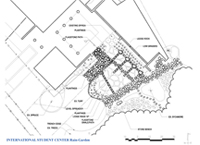
International Student Center Rain-Garden (Photo: Cary Thomsen)
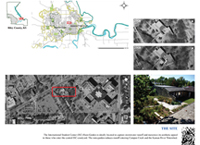
The International Student Center (ISC) Rain-Garden is ideally located to capture stormwater runoff and maximize its aesthetic appeal to those who enter the central ISC courtyard. The rain-garden reduces runoff entering Campus Creek and the Kansas River Watershed. (Photo: Lee R. Skabelund, ASLA)
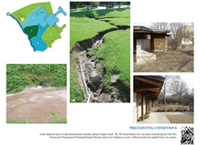
Turtle flights for survival and infrastructure crumbles along Campus Creek. The ISC Rain-Garden site was discovered during the Fall of 2006 Stormwater Management Planning/Design Charrette and is now helping to create a different and more hopeful story on campus. (Photo: Lee R. Skabelund, ASLA)
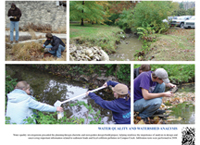
Water quality investigations proceeded the planning/design charrette and rain-garden design-build project, helping reinforce the importance of analysis to design and uncovering important information related to sediment loads and fecal coliform pollution in Campus Creek. Infiltration tests were performed in 2008. (Photo: Lee R. Skabelund, ASLA)
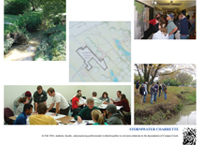
In Fall 2006, students, faculty, and practicing professionals worked together to envision solutions to the degradation of Campus Creek. (Photo: Lee R. Skabelund, ASLA)
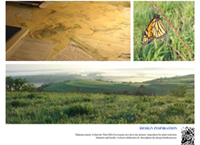
Tall grass prairie within the Flint Hills Eco-region served as the primary inspiration for plant selection. Student and faculty worked collaboratively throughout the design-build process. (Photo: Lee R. Skabelund, ASLA)
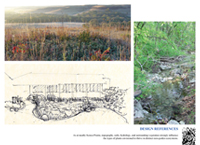
As at nearby Konza Prairie, topography, soils, hydrology, and surrounding vegetation strongly influence the types of plants envisioned to thrive in distinct rain-garden ecosystems. (Photo: Lee R. Skabelund, ASLA; Drawing: Cary Thomsen)
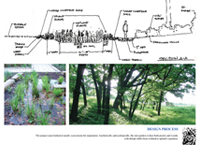
The project team looked at nearby ecosystems for inspiration. Aesthetically and ecologically, the rain-garden evokes both prairie and woods, with abrupt shifts from wetland to upland vegetation. (Photo: Lee R. Skabelund, ASLA; Drawing: Cary Thomsen)
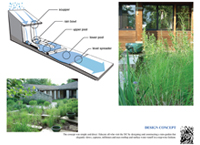
The concept was simple and direct: Educate all who visit the ISC by designing and constructing a rain-garden that elegantly slows, captures, infiltrates and uses rooftop and surface water runoff in a step-wise fashion. (Photo: Lee R. Skabelund, ASLA; Diagram: Jeremy Merrill)
"Really beautiful! Very nice design. This has an opportunity to change the campus."
— 2009 Student Awards Jury
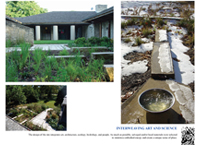
The design of the site integrates art, architecture, ecology, hydrology, and people. As much as possible, salvaged and/or local materials were selected to minimize embodied energy and create a unique sense of place. (Photo: Lee R. Skabelund, ASLA)
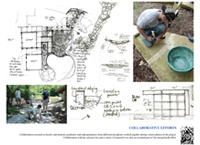
Collaboration occurred as faculty and students (graduates and undergraduates) from different disciplines worked together during various phases of the project. Collaboration with the selected site and a variety of materials was also an essential part of this design-build effort. (Photo and Drawing: Lee R. Skabelund, ASLA)
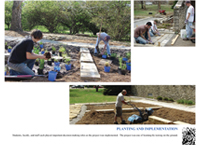
Students, faculty, and staff each played important decision-making roles as the project was implemented. The project was one of learning-by-testing on the ground. (Photo: Lee R. Skabelund, ASLA)
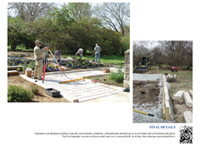
Vegetation was planted according to specific microclimatic conditions, with particular attention given to sun-shade and soil moisture tolerance. The level-spreader was surveyed into send water over a near perfectly level dam, thus reducing concentrated flows. (Photo: Lee R. Skabelund, ASLA)
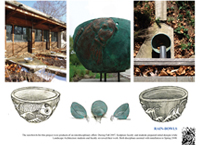
The rain-bowls for this project were products of an interdisciplinary effort. During Fall 2007, Sculpture faculty and students prepared initial designs while Landscape Architecture students and faculty reviewed their work. Both disciplines assisted with installation in Spring 2008. (Photo: Lee R. Skabelund, ASLA; Drawings: Sloan Smith and Stephanie Rogers)
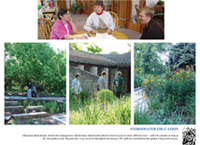
Education about design, stormwater management, and dynamic natural-and-cultural systems occurs in many different ways – and will continue as long as the rain-garden exists. Because they were involved throughout the process, ISC staff are committed to the garden’s long-term success. (Photo: Lee R. Skabelund, ASLA)
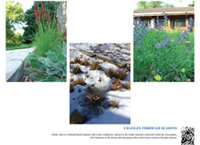
Hardy natives withstand harsh summer and winter conditions, and given the ample moisture collected within the rain-garden, offers lushness in the spring and intriguing colors and textures summer through autumn. (Photo: Lee R. Skabelund, ASLA)



